
Back in February I received two extraordinary gifts from Brother John Paul, CFR: a weekend spent in a hermitage used by the Franciscan Friars of the Renewal and Brother John Paul’s introduction to a groups of cloistered nuns who live not far away, The Monastic Family of Bethlehem, Livingston Manor, NY. I had for several years appreciated the artwork of the nuns and this was a prime opportunity to meet Bethlehem, as it were, and to experience the sacred Liturgy and to drink in, for a very short time, the beautiful monastic atmosphere.
The nuns in Livingston Manor, New York, call themselves officially, “The Monastic Family of Bethlehem and of the Assumption of the Virgin” founded on November 1, 1950, at Saint Peter’s Square in Rome when Pope Pius XII proclaimed the dogma of the Assumption of the Blessed Virgin Mary. The inspiration of French pilgrims was described in this way:

That throughout the world there may exist religious communities devoted to silent adoration, striving to live in continual reference to what the Virgin Mary lives in heaven where she has been taken up with her soul and her body, into the glory of the Three Divine Persons, hidden for ever with Christ in God.
The monks and nuns of the Bethlehem communities, live the scriptural exhortation to seek the face of Christ by living in the school of Mary. From the Mary, the Mother of God, we learn not to set limits on our love of God and neighbor. This seeking of Christ’s face is discerned in the daily work of community living alone and together, in fraternal and liturgical love, and in the sacred Scriptures. In his letter approving the Monastic Family of Bethlehem, Eduardo Cardinal Martinez Somalo said: “The devote themselves to listening assiduously to the Word of God and to prayer of the heart in a life of solitude, silence liturgical and fraternal communion and humble manual work. In order to be faith to this vocation they receive the twofold monastic tradition of East and West. They are disciples of Saint Bruno, receiving his spiritual fatherhood and wisdom of life. With him they are trained in the school of “Divine Philosophy,” which is Jesus Himself, the eternal Wisdom of the Father. They keep a holy watch awaiting the return of their Lord. Their life, then, is entirely ordered to divine contemplation and the greatest possible love for the Divine Persons and for all human persons.” The point, therefore, is to be progressively likened unto Christ Himself.

Seeking that pearl of great price the monks and nuns of this order seek to live with all their heart the evangelical life, though hidden from the world. Life in the Bethlehem Family is life in an eremitical monastery, meaning each nun (or monk depending on the monastery) lives in a hermitage and the hermitages are connected by a cloister leading the to church, the sign of fraternal and liturgical communion. This vocation, from my one experience of being present at the monastery in New York, is lived intently as it is drawn from what Saint Luke observed in his Gospel “and Jesus withdrew to the mountains and prayed” (5:16). The Monasteries of Bethlehem take Saint Bruno’s Rule and his wisdom of life but they are not Carthusians but are affiliated to them in a bond of charity.

The first community of sisters began in 1951 and the monks’ community was founded in 1976, in the Massif of Chartreuse. In 2007, the Bethlehem Family consisted in 650 members from 33 monasteries through out the world.
Work is essential in this life. You quickly learn that the monastic life -or any other style of life for that matter–is not meant for those who want to rest and relax while supervising the work of others. Each nun or monk is expected to contribute to the shared life. For example, when a new monastery is founded the nuns and monks first build their oratory where the Sacrifice of the Mass is celebrated and the Divine Office is sung. Daily bread is earned, not an entitlement that one sees in other orders. Similar to the average working class family in the world today, the monks and nuns work to sustain their life and glorify God. From something to be avoided or disdained, nuns and monks engage their entire being into the work assigned so that the love of God might be expressed, a sign of trust in the “God the creator of heaven and earth.” Here in New York, the Sisters of Bethlehem earn their living by working with their hands. Through their artwork, they seek to convey something of God’s beauty and truth. Their work itself is accomplished in prayer, praise to the Creator of all things and intercession for all those to whom these items are destined.

The Monastic Sisters arrived in Livingston Manor, New York, in May 1987. The monastery is about 2.5 to 3 hours north of New York City. In this monastery, they earn their living by making medallions, icons and chinaware. They also sell dolomite statues, crèches, crucifixes, and bas reliefs made in the monastery of Mougeres France.
My brothers keep a holy and persevering watch awaiting the return of their Master in order to open to Him at once when he knocks, said Saint Bruno.
As Saint Isaac of Nineve said, “When the Spirit makes his dwelling in someone, this person cannot stop praying, for the Spirit does not cease to pray within him.”

In the solitude of the cell, the monk and nun of Bethlehem has this schedule each day:
1 hour of the liturgical hours
45 min of lectio divina (Bible reading)
1.5 hours of personal prayer
1.5 hours of biblical and theological study
c. 2 hours for 2 daily meals and free time
4-5 hours of work
8 hours of sleep
In the church
1.5 hours for Matins and Lauds
1 hour for Mass
30 min of Eucharistic thanksgiving
45 min for Vespers
Monday is a day of complete solitude and on Sunday there is a meal together with a gathering for a chapter meeting and spiritual conversation.
The nuns can be contacted at:
Monastery of Our Lady in Beatitude
393 Our Lady of Lourdes Road
Livingston Manor, NY 12758 USA
tel: 845-439-4300
or
Monastère Sainte Marie Reine des Cœurs
3095, chemin Marie Reine des Cœurs
Chertsey, Québec, J0K 3K0 Canada
or
Monastère Notre Dame de Mongères
F-34720 Caux France
Tel: 33-04-67-98-4486
The motherhouse:
Monastère de l’Assomption Notre-Dame
Currière-en-Chartreuse
F-38380 Saint Laurent du Pont France
Monks tel: 33-04-76-1497
Nuns tel: 33-04-76-4055



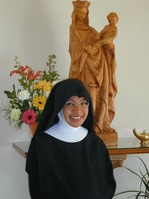

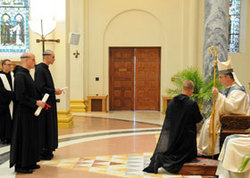
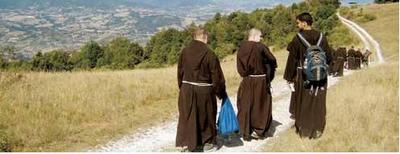
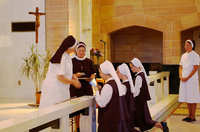
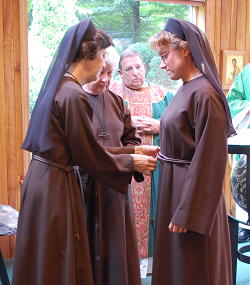

![P5130045[1].JPG](https://communio.stblogs.org/assets_c/2010/05/P5130045[1]-thumb-300x225-6459.jpg)











